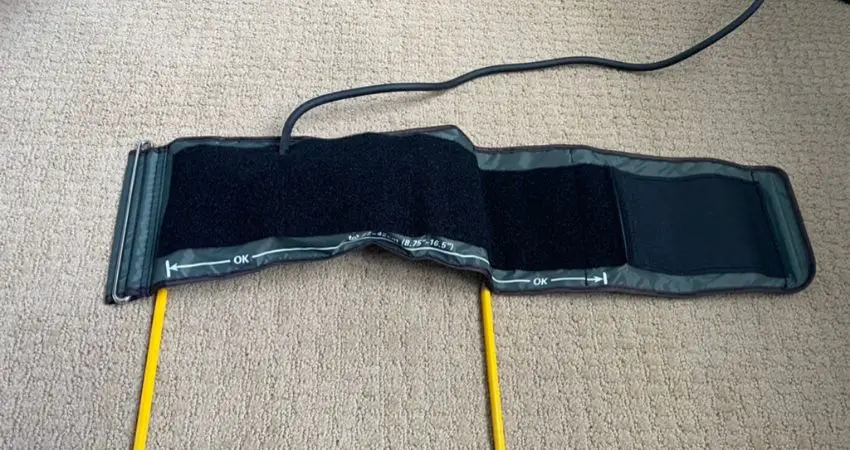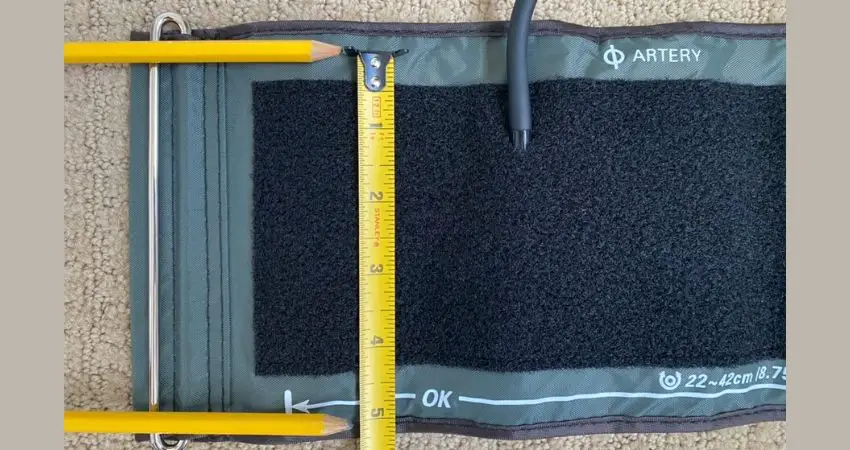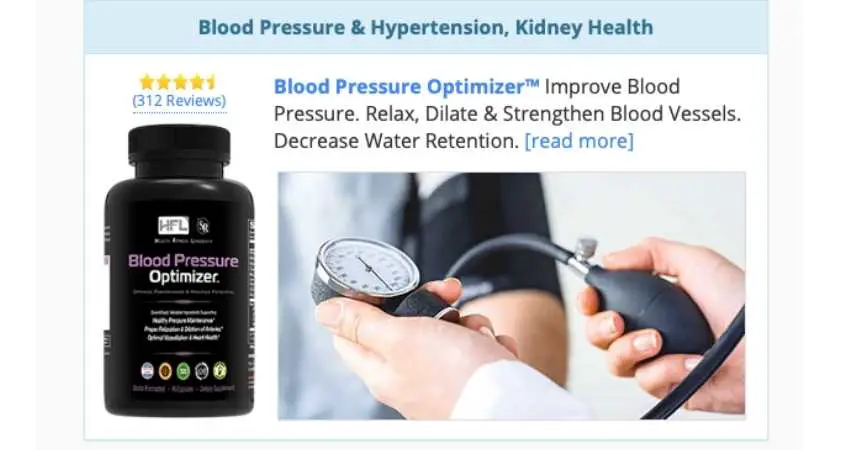There’s a saying that size doesn’t matter. When it comes to blood pressure cuffs the opposite is true. If your cuff is the incorrect size, your measurements can be recorded wrong. Therefore, having the correct cuff size is crucial for measuring pressure. How do you know if a blood pressure cuff is too small?
A blood pressure cuff is too small when its bladder length is less than 75% of the arm circumference or its width is less than 37%. Some blood pressure cuffs are labeled with the ranges of arm size it’s manufactured for. If an arm circumference is less than the lower range indicated, the blood pressure cuff is too small.
For a variety of reasons, some people have the wrong size cuff or one that’s too small. This blog post will dive into those reasons and inform you how to prevent it from happening to you. In addition, how it can make your blood pressure measurements inaccurate.
BP Tip: You can lower BP naturally by changing how you breathe. There’s a device approved by the FDA and The American Heart Association. It guides your breathing a few minutes a day which has been proven to lower BP. You can check it out in the manufacturer’s website by clicking here.
Disclaimer: Some links in this article are affiliate links which means I may earn a small commission at no extra cost to you. As an Amazon associate I earn from qualifying purchases.
How A Blood Pressure Cuff Too Small Affect Measurements
If your cuff is too small, your measurements will be higher. This can cause a diagnosis of high blood pressure when it’s really less, normal or even low1.
So why would a smaller cuff cause your measurement to be higher? A smaller cuff bladder will not wrap around at least 80% of your upper arm. For this reason, it may be unable to completely obstruct the blood flow through the brachial artery. Because of this, when the pressure of the cuff is released the systolic pressure signal starts earlier which results in a higher measurement.
In addition, the extra inflation can feel uncomfortable and squeeze your arm more. The discomfort or pain can cause stress which can make the problem worse2.
The following table indicates how different factors can increase your blood pressure. The first one is using a cuff too small.
| Factor | Systolic Increase (mmHg) |
Diastolic Increase (mmHg) |
| Cuff Too Small | 10 | 2-8 |
| Cuff Over Clothes | 5-50 | None |
| Arm Unsupported | 1-7 | 5-11 |
| Talking or Active Listening | 10 | 10 |
| Back Unsupported | 6-10 | None |
| Full Urine Bladder | 15 | 10 |
| Smoking Within 30 Min. | 6-20 | None |
( Lower Your BP Naturally, In Only 30 Days Or Pay Nothing…Visit Website Here )
BP cuffs too small is one of 14 sections in my article about blood pressure cuffs. Learn more about BP cuffs, including how to apply them, errors made and sizes, here in the article, Blood Pressure Cuffs.
Studies Indicating How BP Increased With a Cuff Too Small
In a study that measured the impact of cuff positioning on blood pressure, they made comparisons with cuffs too small. The researchers found when small cuffs were used, systolic blood pressure increased 4.9 mmHg and diastolic increased 4.0 mmHg3.
Researchers evaluated blood pressure on 137 children aged 4-12-years old. Three different size cuffs were used, too small, correct size and too large. When pressure was measured with a cuff too small, systolic blood pressure increased by 5 mmHg4.
The following table indicates different blood pressure cuff sizes, related arm circumference and cuff bladder dimensions.
| Cuff Size | Arm Circumference – cm. Arm Circumference – in. |
Bladder Size (W x L) – cm. Bladder Size (W x L) – in. |
| Small Adult | 22 – 26 cm 8.66 – 10.23″ |
12 x 22 cm 4.72 x 8.66″ |
| Adult | 27 – 34 cm 10.62 – 13.38″ |
16 x 30 cm 6.29 x 11.81″ |
| Large Adult | 35 – 44 cm 13.77 – 17.32″ |
16 x 36 cm 6.29 x 14.17″ |
| Extra-Large Adult | 45 – 52 cm 17.71 – 20.47″ |
16 x 42 cm 6.29 x 16.53″ |
How You Know If A Blood Pressure Cuff Is Too Small
The following are steps you must take so you can make sure you have the correct size cuff.
Measure the circumference of your upper arm: Using a cloth measuring tape, wrap it securely around your upper arm. Place the cuff midway between your shoulder and elbow. Keep the cloth firm but not tight. Keep you arm hanging straight down and note how many inches.
Purchase the correct size cuff: A home monitor comes with different size cuffs. The cuffs have a range printed on it indicating the upper arm sizes it’s effective for. Make sure your measured arm circumference is within the range of the cuff you’re looking to purchase.
Don’t assume it’s one size fits all, especially if you have arms bigger than a typical size arm. The cuff size on my home monitor has a range from 8.75″ to 16.5″. If you’re looking to buy a new monitor, check out the one I use and recommend in my blog post, Blood Pressure Monitor.
If the cuff doesn’t indicate a size range: Open your cuff and lay it flat on a surface. Feel with your fingers and find where the bladder starts and ends inside the cuff. Tip: you can inflate the cuff with your mouth through the disconnected tube. This will help show you where the bladder is located.
Important: The bladder isn’t the size of the whole cuff material; it’s only a small part. Please see the photos below of my cuff at home indicating where my bladder starts and ends. I manually inflated the bladder.

The photo below indicates the bladder width.

Once you know where the bladder starts and ends, you can check its size against the circumference of your upper arm. The length of the bladder should be no less than 75% of your upper arm circumference. The width should be no less than 37% of your upper circumference.
How Tight Your Blood Pressure Cuff Should Be
Many people group too small and too tight into the same category. Even if you’re using a correct size cuff, it’s possible to wrap the cuff around too tight. When the cuff is wrapped around your upper arm, it should be snug but not too tight. You should be able to slip 2 fingers snugly under the edge of the cuff.
Obese Arms
A client of mine had very large arms because of obesity and the blood pressure cuffs available to her were too small. There are two options; the first is to find the correct size cuff. There are companies selling extra large cuffs which may fit your upper arm.
The monitor I recommend sells a cuff range up to 21.25″. You can check it out along with other large cuffs here.
Another option is to use a wrist cuff. It’s important to use a wrist cuff properly and making a mistake with the cuff height is a common error. I inform you how to use one properly in my blog post which you can read in this website.
Read Next – More BP Cuff Articles!
Can A Blood Pressure Cuff Be Too Tight?
Blood Pressure Cuff Bladder Width
Blood Pressure Cuff Bladder Length
- American Journal Hypertension: P-175: Accurate cuff size in blood pressure measurement [↩]
- Harvard Health: Avoid these common blood pressure measuring mistakes [↩]
- Journal of Hypertension: Impact of cuff positioning on blood pressure measurement accuracy: may a specially designed cuff make a difference? [↩]
- Journal Hypertension: Abstract P182: Quantifying Differences in Blood Pressure by Using Different Blood Pressure Cuff Sizes in Children [↩]
